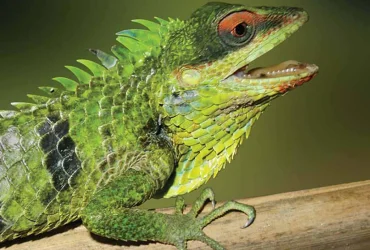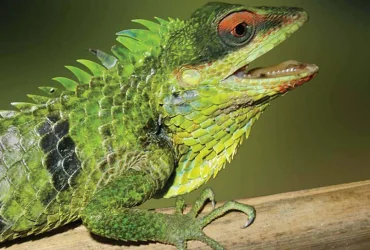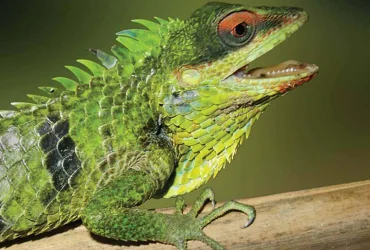Archives
 v1i2.18
v1i2.18ISSN: 1800-427X (print)
eISSN: 1800-427X (online)
DOI:10.47605/tapro.v1i2.18
Submitted date: 15 June 2009
Accepted date: 05 July 2009
Published date: 22 November 2009
Pp. 115–122.
A REVIEW OF THE DISTRIBUTION AND CONSERVATION STATUS OF Chamaeleo zeylanicus LAURENTI, 1768 (REPTILIA : CHAMAELEONIDAE) IN NORTH-WESTERN SRI LANKA
D.M.S. Suranjan Karunarathna, M.A.J. Saman Nawaratne & A.A. Thasun Amarasinghe*
*Corresponding author. E-mail: thasun.taprobanica@gmail.com
Abstract
In this paper we discuss the current status of Chamaeleo zeylanicus including some observations related to the ecology, behaviour, current distribution pattern and conservation issues, based on the north-western population of the species in Sri Lanka. The area from Puttalam to Wanatha-Villuwa has the highest abundance of this species in Sri Lanka. They are deliberately killed by people in this area due to mythical beliefs and folk stories related to this species. Unplanned agricultural practices also destroy their habitats. The Sri Lankan C. zeylanicus population may be different from Indian populations and their taxonomic status has not been investigated.
Key words : Behaviour, chamaeleon, conservation status, distribution, Sri Lanka
Section Editor: Aaron Bauer
eISSN: 1800-427X (online)
DOI:10.47605/tapro.v1i2.18
Submitted date: 15 June 2009
Accepted date: 05 July 2009
Published date: 22 November 2009
Pp. 115–122.
A REVIEW OF THE DISTRIBUTION AND CONSERVATION STATUS OF Chamaeleo zeylanicus LAURENTI, 1768 (REPTILIA : CHAMAELEONIDAE) IN NORTH-WESTERN SRI LANKA
D.M.S. Suranjan Karunarathna, M.A.J. Saman Nawaratne & A.A. Thasun Amarasinghe*
*Corresponding author. E-mail: thasun.taprobanica@gmail.com
Abstract
In this paper we discuss the current status of Chamaeleo zeylanicus including some observations related to the ecology, behaviour, current distribution pattern and conservation issues, based on the north-western population of the species in Sri Lanka. The area from Puttalam to Wanatha-Villuwa has the highest abundance of this species in Sri Lanka. They are deliberately killed by people in this area due to mythical beliefs and folk stories related to this species. Unplanned agricultural practices also destroy their habitats. The Sri Lankan C. zeylanicus population may be different from Indian populations and their taxonomic status has not been investigated.
Key words : Behaviour, chamaeleon, conservation status, distribution, Sri Lanka
Section Editor: Aaron Bauer
 v1i2.17
v1i2.17ISSN: 1800-427X (print)
eISSN: 1800-427X (online)
DOI:10.47605/tapro.v1i2.17
Submitted date: 25 July 2009
Accepted date: 30 September 2009
Published date: 22 November 2009
Pp. 111–114.
AN ABERRANT SPECIMEN OF Calotes grandisquamis GÜNTHER, 1875 (REPTILIA : AGAMIDAE) WITH COMMENTS ON ITS ALTITUDINAL DISTRIBUTION
S. R. Chandramouli*
*E-mail: findthesnakeman@gmail.com
Abstract
An adult female Calotes grandisquamis with unusual colouration was recorded from a low elevation plantation site near the foothills of the Ponmudi Hills, Western Ghats, which proves to be the lowest altitude from which this species has ever been recorded.
Key words : Abnormal coloration, Ponmudi Hills, Western Ghats
Section Editor: Aaron Bauer
eISSN: 1800-427X (online)
DOI:10.47605/tapro.v1i2.17
Submitted date: 25 July 2009
Accepted date: 30 September 2009
Published date: 22 November 2009
Pp. 111–114.
AN ABERRANT SPECIMEN OF Calotes grandisquamis GÜNTHER, 1875 (REPTILIA : AGAMIDAE) WITH COMMENTS ON ITS ALTITUDINAL DISTRIBUTION
S. R. Chandramouli*
*E-mail: findthesnakeman@gmail.com
Abstract
An adult female Calotes grandisquamis with unusual colouration was recorded from a low elevation plantation site near the foothills of the Ponmudi Hills, Western Ghats, which proves to be the lowest altitude from which this species has ever been recorded.
Key words : Abnormal coloration, Ponmudi Hills, Western Ghats
Section Editor: Aaron Bauer
 v1i2.16
v1i2.16ISSN: 1800-427X (print)
eISSN: 1800-427X (online)
DOI:10.47605/tapro.v1i2.16
Submitted date: 23 June 2009
Accepted date: 30 September 2009
Published date: 22 November 2009
Pp. 107–110, pls. 5.
STATUS AND MICROHABITAT PREFERENCE OF Otocryptis beddomii BOULENGER, 1885 (REPTILIA : AGAMIDAE) IN PONMUDI HILLS, WESTERN GHATS, KERALA, INDIA
S.R. Chandramouli*
*E-mail: findthesnakeman@gmail.com
Abstract
The population of Otocryptis beddomii in Ponmudi Hills of Kerala, India was examined to assess its status and microhabitat preference. The encounter rate was significantly higher in pristine habitat (3.51 sightings/km) than in disturbed habitat (0.97 sightings/km). Sighting frequency was highest in rainforests (60) of mid-altitude (68) and the most-utilized substrate was leaf litter (79.2%). Disturbances due to human activities had a significant (Proportion test; z = 2.93, p<0.05), adverse impact on its population.
Key words : altitudinal distribution, encounter rate, habitat quality, sex ratio, substrate
Section Editor: Mohomed Bahir
eISSN: 1800-427X (online)
DOI:10.47605/tapro.v1i2.16
Submitted date: 23 June 2009
Accepted date: 30 September 2009
Published date: 22 November 2009
Pp. 107–110, pls. 5.
STATUS AND MICROHABITAT PREFERENCE OF Otocryptis beddomii BOULENGER, 1885 (REPTILIA : AGAMIDAE) IN PONMUDI HILLS, WESTERN GHATS, KERALA, INDIA
S.R. Chandramouli*
*E-mail: findthesnakeman@gmail.com
Abstract
The population of Otocryptis beddomii in Ponmudi Hills of Kerala, India was examined to assess its status and microhabitat preference. The encounter rate was significantly higher in pristine habitat (3.51 sightings/km) than in disturbed habitat (0.97 sightings/km). Sighting frequency was highest in rainforests (60) of mid-altitude (68) and the most-utilized substrate was leaf litter (79.2%). Disturbances due to human activities had a significant (Proportion test; z = 2.93, p<0.05), adverse impact on its population.
Key words : altitudinal distribution, encounter rate, habitat quality, sex ratio, substrate
Section Editor: Mohomed Bahir
 v1i2.14
v1i2.14ISSN: 1800-427X (print)
eISSN: 1800-427X (online)
DOI:10.47605/tapro.v1i2.14
Submitted date: 15 June 2009
Accepted date: 10 September 2009
Published date: 22 November 2009
Pp. 80–82.
ON THE HOLOTYPE OF Cnemaspis podihuna DERANIYAGALA, 1944
A.A. Thasun Amarasinghe* & Aaron M. Bauer
*Corresponding author. E-mail: thasun.taprobanica@gmail.com
Sri Lankan members of the gecko genus Cnemaspis Strauch, 1887 have recently been reviewed and redescribed. The endemic species Cnemaspis podihuna was first described by P.E.P. Deraniyagala in 1944 from Lahugala-Maha Oya area in Eastern Province based on five specimens (holotype and four paratypes). Deraniyagala (1944) clearly stated “Type - An adult male (fig. I) with the distal half of the tail broken off. Length…..; tail (incomplete) 18 mm. The specimen is in the Colombo Museum.” He also mentioned “Paratypes - An adult female measuring 25 mm. from snout tip to cloaca (tail missing), a half grown specimen, and two young ones.” The original description includes a figure of C. podihuna; this is almost certainly intended to be of the type based on the fact that the figure shows precloacal and femoral pores, a feature restricted to mature male Cnemaspis, and on the basis that the holotype was the only adult male noted by Deraniyagala. Deraniyagala (1953) subsequently provided the same information again in his book-length treatment of the lizards of Sri Lanka.
Section Editor: John Rudge
eISSN: 1800-427X (online)
DOI:10.47605/tapro.v1i2.14
Submitted date: 15 June 2009
Accepted date: 10 September 2009
Published date: 22 November 2009
Pp. 80–82.
ON THE HOLOTYPE OF Cnemaspis podihuna DERANIYAGALA, 1944
A.A. Thasun Amarasinghe* & Aaron M. Bauer
*Corresponding author. E-mail: thasun.taprobanica@gmail.com
Sri Lankan members of the gecko genus Cnemaspis Strauch, 1887 have recently been reviewed and redescribed. The endemic species Cnemaspis podihuna was first described by P.E.P. Deraniyagala in 1944 from Lahugala-Maha Oya area in Eastern Province based on five specimens (holotype and four paratypes). Deraniyagala (1944) clearly stated “Type - An adult male (fig. I) with the distal half of the tail broken off. Length…..; tail (incomplete) 18 mm. The specimen is in the Colombo Museum.” He also mentioned “Paratypes - An adult female measuring 25 mm. from snout tip to cloaca (tail missing), a half grown specimen, and two young ones.” The original description includes a figure of C. podihuna; this is almost certainly intended to be of the type based on the fact that the figure shows precloacal and femoral pores, a feature restricted to mature male Cnemaspis, and on the basis that the holotype was the only adult male noted by Deraniyagala. Deraniyagala (1953) subsequently provided the same information again in his book-length treatment of the lizards of Sri Lanka.
Section Editor: John Rudge
 v1i2.13
v1i2.13ISSN: 1800-427X (print)
eISSN: 1800-427X (online)
DOI:10.47605/tapro.v1i2.13
Published date: 22 November 2009
Pp. 78–79
EDITORIAL
Colin Groves
Section Editor: Taprobanica, the journal of Asian Biodiversity
Considering that Sri Lanka is not a large island, about the size of Tasmania, its biological wealth is simply astonishing. Although the reptiles and amphibians of the island are increasingly well studied, our understanding of the mammals is lagging behind. In the days when Sri Lanka was a British colony, part of British India, there were a few British biologists who paid some attention to the mammals: notably Edward Blyth, curator of mammals in the Indian Museum in Calcutta, and a few taxonomists based in the British Museum (Natural History) in London: Oldfield Thomas, Martin Hinton, Robert Wroughton and Reginald Pocock. As far as I know, none of these scientists had ever actually visited Sri Lanka. Overwhelmingly, however, the basis for our understanding of the mammalian biodiversity of Sri Lanka is due to four people: Kelaart, Phillips, Osman Hill and Deraniyagala. These four had actually lived in Sri Lanka, and Deraniyagala of course was a native of the country. Whereas the outsiders were mainly concerned with differentiating Sri Lankan mammals from those of India, the four "insiders" were alive to the diversity of mammals within Sri Lanka itself, a reality which has imposed itself more and more on our consciousness over the years.
eISSN: 1800-427X (online)
DOI:10.47605/tapro.v1i2.13
Published date: 22 November 2009
Pp. 78–79
EDITORIAL
Colin Groves
Section Editor: Taprobanica, the journal of Asian Biodiversity
Considering that Sri Lanka is not a large island, about the size of Tasmania, its biological wealth is simply astonishing. Although the reptiles and amphibians of the island are increasingly well studied, our understanding of the mammals is lagging behind. In the days when Sri Lanka was a British colony, part of British India, there were a few British biologists who paid some attention to the mammals: notably Edward Blyth, curator of mammals in the Indian Museum in Calcutta, and a few taxonomists based in the British Museum (Natural History) in London: Oldfield Thomas, Martin Hinton, Robert Wroughton and Reginald Pocock. As far as I know, none of these scientists had ever actually visited Sri Lanka. Overwhelmingly, however, the basis for our understanding of the mammalian biodiversity of Sri Lanka is due to four people: Kelaart, Phillips, Osman Hill and Deraniyagala. These four had actually lived in Sri Lanka, and Deraniyagala of course was a native of the country. Whereas the outsiders were mainly concerned with differentiating Sri Lankan mammals from those of India, the four "insiders" were alive to the diversity of mammals within Sri Lanka itself, a reality which has imposed itself more and more on our consciousness over the years.
Hubungi Kami
The ultimate aim of the journal is to provide an effective medium for communication of the latest and best scientific information.
Copyright © 2020 Taprobanica. All Rights Reserved
Jasa Pembuatan Website by IKT




